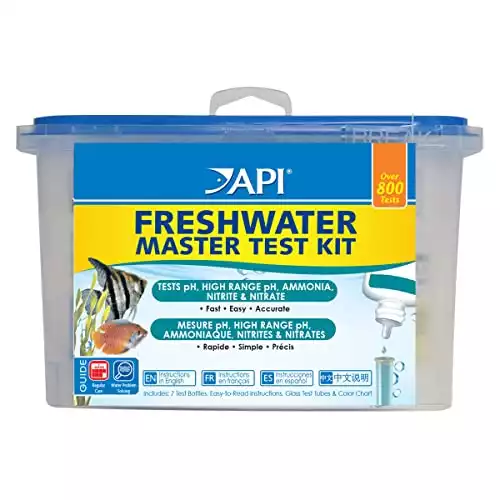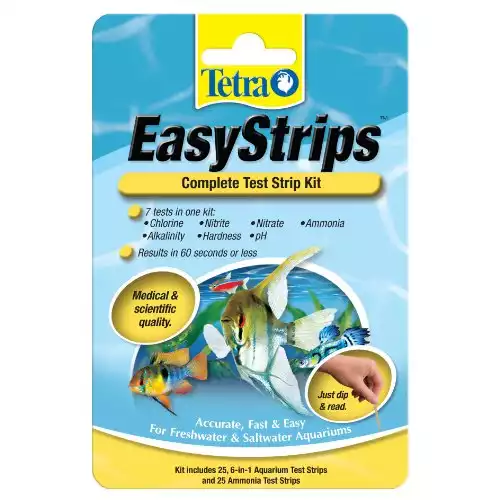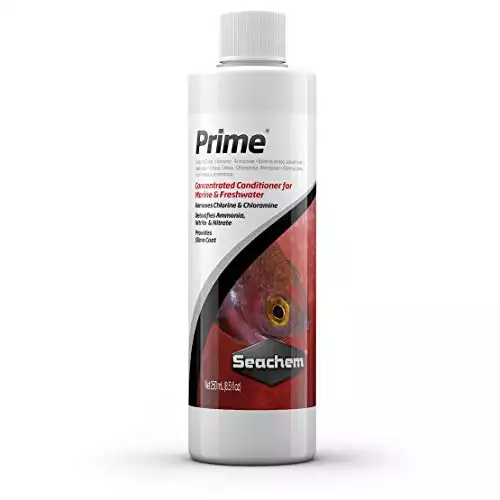
In this article, we’ll explore the various factors that might be causing your fish to hide away in their tank.
Fish hide when under stress, whether it be aggressive tank mates, illness, or poor water quality.
It’s very common for new fish added to an aquarium to hide for a few days until they settle in and feel safe, this isn’t anything to worry about.
Providing plenty of hiding spots such as plants, rocks, or caves is a great way to help your fish feel safe and gives them somewhere to go and relax when it all gets too much for them!
If you find your fish are still hiding after a few days, adding dither fish can be a great option to help coax shy fish out into the open.
Why Do My Fish Hide?
Here are the 6 most common reasons why fish hide.
1. New Environment
When you first introduce a new fish to your aquarium it might hide due to the unfamiliar surroundings.
It takes time for fish to become comfortable and explore their new home.
This is especially the case for non-schooling species, which often hide away for a few days and claim their own little spot in the tank until they feel it’s safe to venture out.
2. Predators and Threats

Fish are aware of potential predators and threats in their environment.
They might hide to avoid predators such as larger fish or if they feel threatened.
- Aggressive tankmates: Some fish are territorial and may be aggressive, causing smaller or more timid fish to seek shelter.
- Large Fish: Some larger fish will eat smaller fish, try to avoid putting small fish in with much larger fish. If it will fit in the bigger fish’s mouth, it may become a tasty snack!
- Other Household Pets: Do you have a cat that likes to paw at the tank or lay on the lid? It may look cute but will probably stress your fish, causing them to hide.
- Tank Location: Is the tank located in a busy area or your home? People constantly walking past and making noise can cause timid fish to hide.
3. Sickness and Stress

Fish may hide or lay on the bottom of the tank when they are sick or stressed, a bit like us humans when we feel unwell and go to bed or lay on the sofa feeling sorry for ourselves!
Poor water conditions, such as inadequate filtration, excess waste, or incorrect pH levels, can contribute to stress and illness in fish.
If a fish is hiding due to sickness, it is crucial to address the underlying issue quickly.
Some common illnesses or diseases to watch out for are:
To help create a healthy environment to reduce disease outbreaks in your fish tank:
- Maintain good water quality by properly filtering and monitoring water parameters.
- Introduce new fish carefully, allowing them to adjust to their new surroundings.
- Avoid overcrowding to reduce stress and aggression among tankmates.
- Monitor fish for signs of illness and take appropriate action when needed.
4. Overstocked Fish Tank

Your fish can become stressed and sick when you have an overstocked tank.
It is hard to maintain stable water parameters in an overstocked tank and you have a much higher risk of aggression between your fish due to the lack of space.
If this is the case, consider upgrading to a larger tank or re-home the aggressive fish.
5. Lighting
Some fish do not like a brightly lit tank, so they will retreat to the bottom of the tank or hide amongst the decor where it’s darker.
Reduce the amount of time your light is switched on (8-10 hours per day is optimum), using a timer is a great way to make sure you don’t forget to switch your light off at night.
To help reduce the brightness in your tank, you could also add some floating plants.
6. Water Flow
If the water flow from your filter is too strong, it can cause your fish to hide at the bottom of the tank, where the flow isn’t as strong.
This is particularly problematic with fish with long flowing fins, such as Betta Fish or fancy Goldfish, as they are not the strongest swimmers.
Many filters have an adjustable flow rate lever/knob so that you can reduce the flow rate if needed.
Understanding Fish Behavior
Territorial and Schooling Fish

Some fish are naturally territorial and may claim a specific area within the tank as their own. In such cases, hiding may be a way for the fish to feel secure in their space.
Whereas schooling fish feel safer when they are part of a group. If your fish is a schooling species and is hiding, it could be an indication that they feel threatened or insecure due to a lack of companions.
Some common schooling fish are:
- Celestial Pearl Danio
- Cherry Barb
- Harlequin Rasbora
- Pygmy Corydoras
- Tetras
- Zebra Danio
Shy and Skittish Fish
Certain fish species have a more timid nature and may hide out of shyness or fear.
To help alleviate your fish’s stress, maintain good water conditions and make sure you provide plenty of hiding spots for them to retreat to when they feel scared.
Keep an eye out for any aggressive fish that may harass or intimidate timid tank mates.
How To Create A Healthy Environment For Fish
A happy, healthy, and relaxed fish is going to be more active and swim around rather than hide away.
There are a few things you need to do to create a healthy environment for your fish.
Water Quality
Water quality is the No.1 factor when it comes to creating a healthy environment for your fish.
It’s important your water parameters are stable and that your tank is kept clean.
Water Parameters
Keep an eye on the water parameters, a sudden change in temperature, pH, or spike in ammonia, nitrite or nitrates will make your fish feel stressed, leading them to find refuge in hiding spots.
Regularly test your aquarium’s water with a water test kit or strips, and take the necessary steps to maintain a stable environment for your fish.
4.7 | 4.5 |
The API freshwater test kit offers outstanding value (over 800 tests!) and is very accurate, if you're serious about fishkeeping this is the best test kit to buy and the only one I use. | The Tetra test strips are quick & easy to use and measure all the vital water parameters that you need to monitor to keep your fish safe, but it can be difficult to read the colors, making them less accurate than the API water test kit. |
$13.49 | |
The API freshwater test kit offers outstanding value (over 800 tests!) and is very accurate, if you're serious about fishkeeping this is the best test kit to buy and the only one I use.
The Tetra test strips are quick & easy to use and measure all the vital water parameters that you need to monitor to keep your fish safe, but it can be difficult to read the colors, making them less accurate than the API water test kit.
Water Changes
Water changes help lower nitrates, but can also cause your fish to hide. When you alter their environment, even slightly, it can cause stress for them, they are sensitive little souls!
To minimize these effects, try to keep the water parameters stable during water changes so that the temperature and pH levels don’t change suddenly.
Make sure any new water added to your tank has been treated with a water conditioner first so that harmful toxins have been detoxified, making it safe for your fish.
Seachem Prime is an essential item for ALL fishkeepers!
It removes chlorine and chloramine from tap water.
It detoxifies ammonia, nitrite & nitrate, making the aquarium water safe for your fish.
Directions: Add 5 ml per 50 gallons (200 liters) for regular detoxification.
Up to 5 times the dose (25 ml per 50 gallons) can be used in an emergency if ammonia or nitrites exceed 2 ppm.
- Easy to use
- Removes chlorine & chloramine
- Detoxifies ammonia, nitrite & nitrate
- Doesn't expire (if stored correctly)
- Suitable for fresh & saltwater aquariums
- Strong sulphur smell
Water Temperature
You should aim to keep your water temperature consistent and suitable for the type of fish you are keeping.
Sudden temperature changes will stress your fish. Using an aquarium thermometer is a super simple way to monitor this.
Different types of fish prefer different water temperatures, e.g. betta fish are tropical fish, so they require the water to be heated to around 78°-82° F / 25.5°-27.5°C whereas Goldfish prefer cooler water of around 65°-72° F / 18°C-22°C.
If the water is too warm, your fish may go hide out at the bottom of the tank where it’s a bit cooler.
Filtration
An efficient filtration system is essential for maintaining good water quality and the overall health of your fish.
Poor water quality will lead to your fish becoming stressed and ill, which may cause them to hide.
Creating Hiding Places
Incorporating various types of decor in your aquarium setup is an excellent way to create hiding spots for your fish, to help them feel safe and relaxed.
Driftwood
Aquarium-safe driftwood is a natural way to lower the pH level in your aquarium.
It also provides somewhere for your fish to explore and rest on.
Soak overnight before adding to your aquarium, so that it sinks to the bottom & doesn't float away!
Driftwood offers multiple hollows and crevices for fish to hide in.
When selecting driftwood, ensure it is aquarium-safe and thoroughly cleaned before placing it in your tank, it’s also a good idea to sand down any sharp edges so your fish don’t injure themselves.
Plants and Rocks
Aquatic plants and rocks can significantly contribute to a more enriched and natural environment for your fish.
Plants offer many benefits in an aquarium, they look great, help soak up excess nitrates in the water and provide lots of hiding spots for your fish.
Arranging rocks into cave-like structures offers additional hiding spots and helps to mimic your fish’s natural habitat.
Caves and Structures
In addition to using plants and rocks, store-bought hiding caves or pipes work well.
Alternatively, if you have any spare clay plant pots laying around (give them a good wash), they make a great hiding spot for free!
Quarantine New Fish
Before adding new fish to your aquarium, it’s essential to quarantine them for a week or two in a separate tank.
This ensures they don’t have any parasites or fungal infections that could infect the rest of your fish population.
During the quarantine period, observe the new fish closely for any signs of illness, such as lethargy, loss of appetite, or unusual behavior.
If you notice any symptoms, treat them quickly and ensure they are fully recovered before putting them in your main tank to avoid a disease outbreak.
Conclusion For Why Does My Fish Hide?
So to wrap up, if you have just added a new fish to your tank, it’s perfectly normal for them to hide out for a few days until they have adjusted to their new home, so don’t worry.
If you have a fish that is generally lively and out in the open and then suddenly hides, you need to find out quickly why this is. Generally, it’s because the water parameters have gone out of whack or illness.
You’ll hopefully now know why your fish are hiding and have some actionable solutions to help coax the little guys out!
Check out the aquarium health section for guides and tips to keep your aquarium in tip-top shape.






